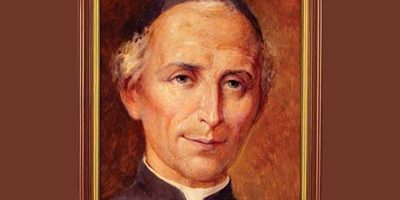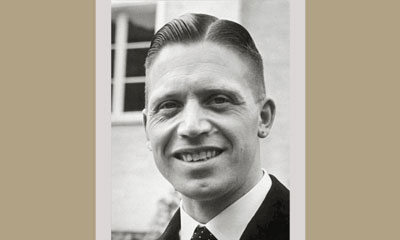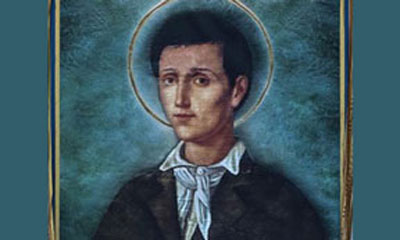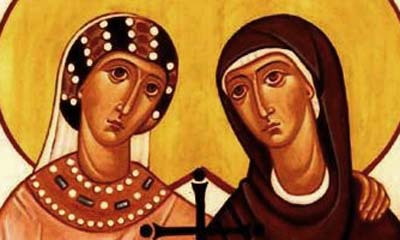September 5, 2019
Venerable Bruno Lantéri
Dear Friends,
“After reflection, I have no desire stronger, or even as strong, as that of having Jesus Christ reign in my soul and in those of other men through faith, hope and charity”. Such was the inner disposition of all members of “Christian Friendship”. This association, which spread across all of Europe, played a leading role in restoring the religion after the upheavals of the French Revolution, preparing zealous and educated Catholics everywhere who would have a very great influence. Bruno Lanteri was its soul, prior to his founding of a Marian congregation of priests.
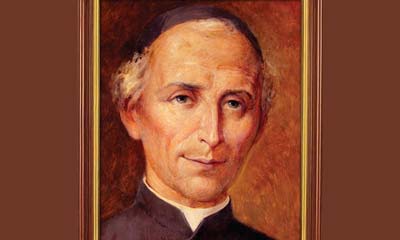 Bruno Lanteri was born on May 12, 1759 in Cuneo, a small city in Piedmont (northwest Italy). He was the seventh of ten children. His father, a doctor, was called “the father of the poor” because of his great charity. Bruno was only four years old when his mother died in childbirth. He would later say, “I have had almost no mother except the Blessed Virgin Mary, and I have received only caresses from such a good Mother.” In 1781, he wrote an act of consecration of his entire being to the Virgin Mary, making Her his true and absolute mistress. From an early age, he showed an interest in reading and a fierce intelligence: he wanted to know and understand everything. His father fully supported his son’s interests: “I studied with my father even at meals,” Bruno would say. At 17, he tried to become a Carthusian. But the Prior soon realized that Bruno was not made for the harsh life of his Order, and sent him home.
Bruno Lanteri was born on May 12, 1759 in Cuneo, a small city in Piedmont (northwest Italy). He was the seventh of ten children. His father, a doctor, was called “the father of the poor” because of his great charity. Bruno was only four years old when his mother died in childbirth. He would later say, “I have had almost no mother except the Blessed Virgin Mary, and I have received only caresses from such a good Mother.” In 1781, he wrote an act of consecration of his entire being to the Virgin Mary, making Her his true and absolute mistress. From an early age, he showed an interest in reading and a fierce intelligence: he wanted to know and understand everything. His father fully supported his son’s interests: “I studied with my father even at meals,” Bruno would say. At 17, he tried to become a Carthusian. But the Prior soon realized that Bruno was not made for the harsh life of his Order, and sent him home.
A special grace
Bruno then directed himself to the priesthood. At the time, candidates began by taking the cassock with the permission of the bishop, and then prepared for Holy Orders by studying theology at a university or seminary. In September 1777, Bruno obtained such permission from his bishop, and began his studies at the University of Turin. He found himself in an intellectual atmosphere influenced by the Jansenist heresy; books circulated that discouraged the faithful, considered insufficiently worthy, from frequenting the sacraments. They even discouraged the faithful from receiving communion at Easter, or Viaticum as death approached. Christians were urged to renounce their devotions to the saints and recitation of the Rosary. Confessors were told to absolve sins only rarely, and only after long penances imposed on the penitents. At the beginning Bruno Lanteri adopted these very rigid positions, but a few wiser theologians helped him develop better discernment. Father Loggero, who would serve as Bruno’s secretary for many years, wrote: “At the University of Turin, he associated with a priest who did his best to win him to Jansenism… Father Lanteri attributed his enlightenment on these questions to a singular grace of the Lord which enabled him to recognize the falsity of these doctrines, after which he avoided the company of this priest.” Father von Diessbach, a former Jesuit (Pope Clement XIV had dissolved the Society of Jesus in 1773) whom Bruno met in Turin in 1779, had the most positive influence on Bruno. Through his word and his pen, this very active priest fought loss of faith, Jansenism, and regalism.
In early 1782, Father von Diessbach asked Bruno to follow him to Vienna, Austria, to aid Pope Pius VI, who would be there to negotiate with Emperor Joseph II. For the previous two years, the Emperor had been claiming authority over the discipline and life of the Church and infringing upon its freedom (this was called Josephism or regalism). In Vienna, Bruno participated in conferences on canon law and theology, an experience that would serve him for the rest of his life. Then, on Father von Diessbach’s advice, he returned to Turin. In 1776, Father von Diessbach started an association, the Christian Friendship, whose goal was to unite Catholics in Piedmont for the glory of God, their personal sanctification, and the defense of morals and dogma against rationalists, through the sharing of good books. He relied on Bruno to manage this association.
Listen carefully
In May 1782, Bruno was ordained to the priesthood, and he received a doctorate in theology that July. Because of his severe near-sightedness, he had to listen carefully to his university professors, to the point where he later said he learned theology “more through my ears than my eyes.” With his bishop’s approval, he gave up his ministry in 1784 to focus on the Christian Friendship. Since respiratory problems prevented him from preaching to large audiences, he gave the spiritual Exercises of St. Ignatius to small groups, becoming a popular spiritual director. The next year, he passed the examination required to become a confessor. Every day Bruno devoted many hours to exercises of piety: the breviary, prayer, Mass, the rosary, visits to the Blessed Sacrament, spiritual reading. He carefully chose good books to share, because he knew how damaging Jansenist works could be. He also stayed abreast of political, social, and religious events, particularly the progress of the French Revolution, in order to be able to offer resistance to the evils afflicting society. Works of charity for the poor, the sick, prisoners, and the disadvantaged, whom he sought out everywhere—in cafés, slums, and gatherings—also played an important role in his life and the lives of other members of the Christian Friendship.
Following the Revolution, France annexed Piedmont, Bruno’s homeland. The 1801 Concordat between France and the Holy See, signed by Pope Pius VII and Napoleon, was later unilaterally modified by the Emperor, who surreptitiously added the Organic Articles, giving him the right to interfere with the affairs of the Church. To defend the Church’s freedom, Lanteri wrote tracts denouncing this encroachment of the State, which were secretly copied and distributed by members of Christian Friendship. Other important texts, written by bishops, the Pope, and trusted theologians, were also discretely distributed. In 1806, Napoleon imposed a catechism throughout the Empire that taught that everyone owed unlimited obedience to the Emperor. Bruno vigorously refuted this claim in a tract that was widely copied and distributed. He also worked to combat Jansenism, which he criticized for disfiguring Jesus Christ and His teachings and of misunderstanding His divine mercy and love for sinners. Meanwhile, the Jansenists accused him of laxity, of putting pillows under the elbows of sinners (Ezek. 13:18), and of relying on the works of a holy bishop and founder of an Order who had died in 1787, Alphonsus Liguori. Liguori insisted, in opposition to the Jansenists, that Jesus Christ died for all men without exception, acquiring for them an infinite treasure of merits for their eternal salvation. Through prayer, all have the ability to draw on this treasure for the help they need, the grace of prayer being available to everyone: “Whoever prays, saves himself; whoever does not pray is lost” (Alphonse Liguori, quoted in the Catechism of the Catholic Church, No. 2744). He encouraged all to approach the Savior with great trust in His infinite mercy. He taught confessors not to defer absolution on the pretext of unworthiness, but to grant it freely as soon as the sinner displayed sufficient contrition. The Church canonized Alphonsus Liguori in 1839, naming him patron saint of moral theologians and of confessors. Bruno adopted these teachings, to the point that one of his friends said of him, “In Piedmont he was the defender of sound theology and sound morality; he was the most powerful hammer against Jansenism.”
La Grangia
Bruno Lanteri maintained his spiritual life through the Exercises of St. Ignatius, which he practiced often. For him, retreats were “a most potent instrument of divine grace and a sure way for everyone to become a saint, and even a great saint.” The spiritual Exercises are “a way of preparing and disposing a soul to rid itself of all inordinate attachments and, after their removal, of seeking and finding the will of God in the dispositions of our life for the salvation of our soul” (The Spiritual Exercises of St. Ignatius of Loyola, No. 1). At the very beginning of his priesthood, Bruno wrote a series of talks for his use in giving the Exercises, after which he never stopped improving this work, which he viewed as particularly important. He initially offered the retreats in retreat houses which were later closed under the French occupation. So Bruno converted La Grangia, a country house he owned near Turin, into a retreat center that could host around twenty people. The retreats usually lasted eight days. Bruno Lanteri had his own style of preaching the Exercises, which gave the meditations a unique flavor. His originality came from the fact that he started where others ended: instead of finishing with a contemplation on divine love, he began by immersing participants in this love.
In his contemplation to obtain Divine Love, St. Ignatius wrote: “I will recall to mind all the benefits that I have received: those which I share with all men—creation and redemption—and those that are particular to me, considering with great affection how much God our Lord has done for me, and how much He has given me of what He possesses, and how much He desires to give Himself to me—as much as He can—according to the disposition of His divine Providence. Then I will reflect on my side of things, and consider what reason and justice require me to offer and give to His divine Majesty in return, which is, all that I possess and myself with it. Then, as one offering a gift, I will say from the bottom of my soul: Take, Lord, and receive all my liberty, my memory, my understanding, and my entire will, all that I have and possess. Thou hast given all to me. To Thee, O Lord, I return it. All is Thine, dispose of it wholly according to Thy good pleasure. Give me Thy love and Thy grace, this is sufficient for me.” (Spiritual Exercises, No. 234).
Supporting the Pope
In May 1809, Napoleon annexed the Papal States to the French Empire. In response to this injustice, which had been preceded by several others, the Pope imposed the penalty of excommunication against the Emperor. Napoleon then had the Pope taken to Savona and held captive. Bruno Lanteri’s first act was to organize an association to provide for the Pope’s material needs, since the Pontiff had refused the Emperor’s insulting allowance. Thanks to the work of the Christian Friendship, Lanteri was able to collect large sums of money that were discreetly given to the Pope, in spite of police surveillance. But the Pope also wanted to be kept informed of current events, and he needed certain documents to reference in refuting the claims of civil power over that of his spiritual authority. Thanks in particular to Father Lanteri, astonishing amounts of devotion and expertise emerged in Turin as well as in France supporting the Pope. In fact, the director general of the police, noting that news transmitted by the Catholics traveled faster than the government couriers, wrote: “I never knew how the priests managed it!” However, Bruno’s activity was not without danger: anyone who provided the prisoner of Savona with documents that had not been submitted for Imperial censorship risked the death penalty or deportation. Disregarding this danger, Bruno continued his activities, providing the Pope with the means to write letters that were sent to cardinals and bishops, and even distributed to the public. In 1811, the Emperor summoned the national council to appoint bishops without the Pope’s consent. Bruno denounced this new interference in the Church’s governance in a widely distributed document. Napoleon was outraged, and ordered searches to find those responsible for these acts of resistance. Bruno was already under police surveillance, and was therefore a primary suspect. Though no charges were brought against him, he was placed under house arrest at La Grangia. He remained there from March 25, 1811 until the fall of the Empire in 1814. This time of solitude, reading, rest, and recollection benefited him greatly. He received a number of visitors, and continued his apostolate of preaching the Exercises of St. Ignatius. He also wrote tracts supporting the Church and the Pope, which were then secretly distributed.
In April 1814, following Napoleon’s abdication, Pius VII returned to Rome and Bruno Lanteri returned to his work in Turin, with new energy and improved health. He resumed his leadership of the Christian Friendship, as well as its branch for priests, the Sacerdotal Friendship group, both of which had suffered from persecution. Conditions having changed, the absolute secrecy that had protected members from accusations and worldly intrigues was no longer necessary. The time had come to work openly. This allowed the group to distinguish itself from the secret societies which were then spreading, such as the freemasons. The name of the association was changed to Catholic Friendship, and its distribution of good books continued. In 1825, the Marquis Cesar d’Azeglio, a fervent disciple of Lanteri and a leader of the Friendship, wrote: “In the eight years of the Friendship’s existence, hundreds of thousands of volumes have been distributed, more than 10,000 of which have been sent to America.” Charles Felix, King of Piedmont-Sardinia, initially gave his support to the Catholic Friendship and offered generous subsidies, even giving himself the title of First Catholic Friend. But the association’s opponents brought constant attacks before the King, portraying the Friendship as a dangerous sect that sought to dominate governments and submit all secular authority to the omnipotence of the Pope. Bit by bit, Charles Felix allowed himself to be influenced, and he finally dissolved the Catholic Friendship in the spring of 1827.
A Marian congregation
In 1815, three zealous priests from Carignano, a small city near Turin, decided to work together for their sanctification and the salvation of souls through preaching, confession, opening a school for candidates to the priesthood, and practicing charity towards the poor. They soon asked Bruno to assume leadership of the group. He accepted and drafted several short and precise rules. In November 1816, he requested and obtained authorization to found a new congregation from the capitular vicar of Turin, since the episcopal see was vacant. The institute was named the Congregation of the Oblates of the Virgin Mary. The new Oblates immediately began preaching the spiritual Exercises of St. Ignatius, with immediate success: there were many confessions and conversions, at times momentous, of hardened sinners.
Nevertheless, Lanteri could not yet abandon his work in Turin, especially since he wanted to open an ecclesiastical residence where newly ordained priests could live while they completed their studies. This residence began modestly in the fall of 1817, under the direction of a close friend of Bruno’s. He was finally able to take charge of the small community of Oblates, making St. Thomas Aquinas its first teacher, and Alphonsus Liguori its second. Bruno wanted the Oblates to specialize in preaching popular missions, in the form of the spiritual Exercises given to a whole parish. This ministry of the Oblates bore beautiful fruit, restoring freedom to hearts darkened by Jansenism, and opening them to joy of Christ by helping them love the One who said: “My yoke is easy and My burden light!” (Matt. 11:30). In a single year, more than 1,400 people returned to religious practice, and many vocations began to steam to the new institute.
Great humility
Following this initial success, Father Lanteri thought the moment had come establish this work on canonical foundations. But he ran into opposition from the new Archbishop of Turin. A former Camaldolese monk, the archbishop told Bruno in no uncertain terms that he could not approve the moral doctrines of Alphonsus Liguori, since he considered them too favorable to the general relaxation of morals. Furthermore, he didn’t see the purpose of founding a new congregation. Two years passed without approval. During this time, other people also created difficulties for the Oblates, rendering their situation untenable. Fortified by the Exercises of St. Ignatius, Father Lanteri received these contradictions and humiliations peacefully, as Christ had received the humiliations of his Passion. With great humility, he dissolved the institute, expressing no recrimination or complaint against his adversaries. In July 1820, the Oblates quietly dispersed, and several sought to join the Jesuits. Bruno himself began this process, undertaking the spiritual Exercises to reflect on this decision before God. In them, the will of God appeared clear to him: his purpose was not to enter the Jesuit novitiate, but to restore the institute of the Oblates. Confiding in Mary, he said, “The congregation is the work of the Madonna. She will take care of it.” In September 1825, Bishop Rey, the new bishop of Pinerolo, who enthusiastically supported the work of the Oblates, sent a letter approving the institute’s restoration. In 1826, he asked Father Lanteri to organize a large mission at his cathedral in Pinerolo. Following the impressive success of this mission, Bruno agreed to restore the Oblates in Pinerolo. On September 1 of that year, a papal brief approved the Congregation. In 1827, King Charles Felix, convinced by the archbishop, approved the decision.
Bruno Lanteri established himself in Pinerolo, where his strength began to wane. In early 1830, he was suffering from many infirmities and in great pain, but his life was constant prayer, a loving and peaceful attentiveness to the presence of God. He often repeated, “O good Jesus, I thirst for You.” He had an opening made in the wall of his room, which was adjacent to the chapel, so that he could see the tabernacle. Devotion to Mary continued to hold a special place in his heart. During his last days, he would say, “I see a beautiful Lady with a beautiful Child in Her arms, and She never leaves me!” As long as he had the strength, he celebrated Holy Mass. He mounted the holy altar for the last time on the Feast of St. Joseph, March 19, 1830. On August 5, he entered his agony. “Love one another, love one another profoundly, and always remain one at heart, whatever it may cost you!” he whispered to his sons. After having heard the words of Jesus, “Holy Father, keep them in Thy name, which Thou hast given Me, that they may be one, even as We are one.” (John 17:11), he took his last breath. The cause of his beatification is currently underway.
Let us ask the Blessed Virgin Mary to give us great ardor to serve the Lord, whatever obstacles and difficulties we may face!


